Dada and Riot-Response Cinema: Avant-Garde and Experimental Context
VerifiedAdded on 2023/01/19
|13
|4214
|63
Essay
AI Summary
This essay undertakes a comparative analysis of two significant films: "Handsworth Songs" and "Cabaret Voltaire," examining their formal characteristics and thematic concerns within the broader context of avant-garde and experimental cinema. The essay delves into the rise of Dadaism, tracing its roots to the Cabaret Voltaire in Zurich and its rejection of societal norms and embrace of irrationality. It contrasts this with the riot-response genre, exemplified by "Handsworth Songs," which documents the social and political unrest in 1980s Britain, particularly the riots in Handsworth, Birmingham, and London, and how these events shaped the lives of the people. The analysis explores how societal events and artistic movements influenced each other, highlighting the unique contributions of each film to the evolution of cinema and the representation of societal issues. The essay also examines the experimental techniques employed in both films, such as the use of archival footage, personal narratives, and non-linear storytelling, to convey their respective messages. Ultimately, the essay demonstrates how both films, through their distinct approaches, challenged conventional filmmaking and provided a critical commentary on their respective historical contexts.
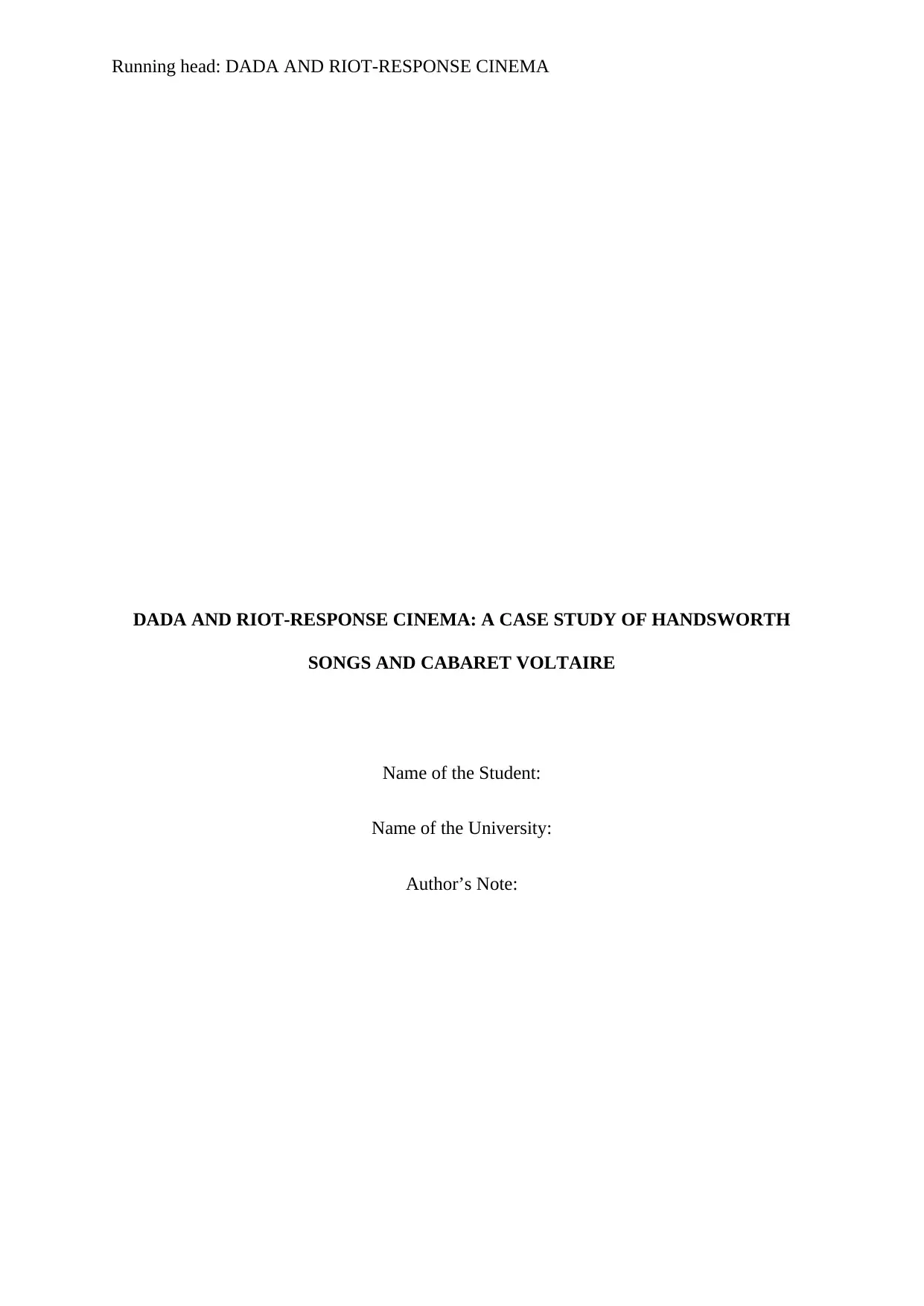
Running head: DADA AND RIOT-RESPONSE CINEMA
DADA AND RIOT-RESPONSE CINEMA: A CASE STUDY OF HANDSWORTH
SONGS AND CABARET VOLTAIRE
Name of the Student:
Name of the University:
Author’s Note:
DADA AND RIOT-RESPONSE CINEMA: A CASE STUDY OF HANDSWORTH
SONGS AND CABARET VOLTAIRE
Name of the Student:
Name of the University:
Author’s Note:
Paraphrase This Document
Need a fresh take? Get an instant paraphrase of this document with our AI Paraphraser
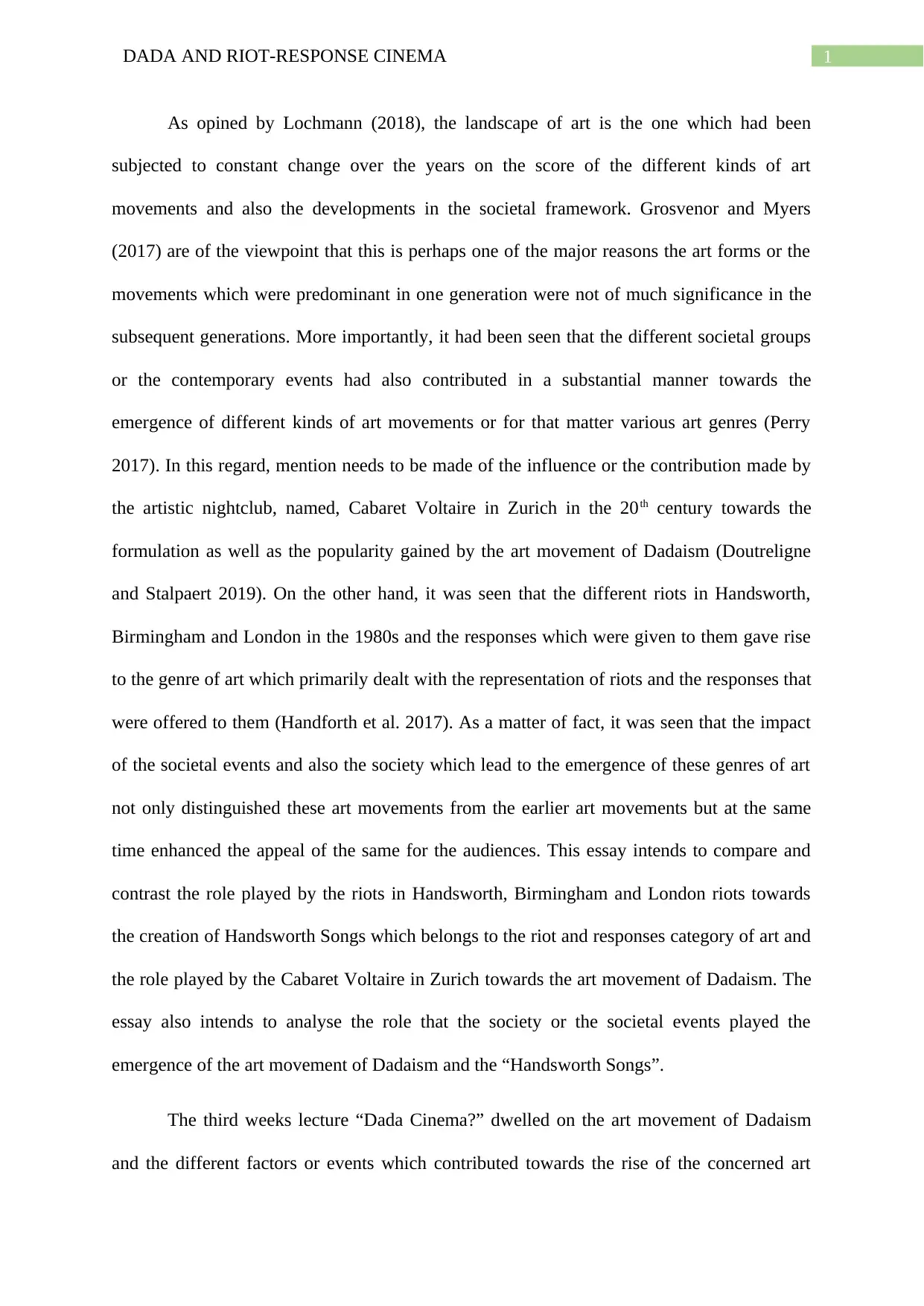
1DADA AND RIOT-RESPONSE CINEMA
As opined by Lochmann (2018), the landscape of art is the one which had been
subjected to constant change over the years on the score of the different kinds of art
movements and also the developments in the societal framework. Grosvenor and Myers
(2017) are of the viewpoint that this is perhaps one of the major reasons the art forms or the
movements which were predominant in one generation were not of much significance in the
subsequent generations. More importantly, it had been seen that the different societal groups
or the contemporary events had also contributed in a substantial manner towards the
emergence of different kinds of art movements or for that matter various art genres (Perry
2017). In this regard, mention needs to be made of the influence or the contribution made by
the artistic nightclub, named, Cabaret Voltaire in Zurich in the 20th century towards the
formulation as well as the popularity gained by the art movement of Dadaism (Doutreligne
and Stalpaert 2019). On the other hand, it was seen that the different riots in Handsworth,
Birmingham and London in the 1980s and the responses which were given to them gave rise
to the genre of art which primarily dealt with the representation of riots and the responses that
were offered to them (Handforth et al. 2017). As a matter of fact, it was seen that the impact
of the societal events and also the society which lead to the emergence of these genres of art
not only distinguished these art movements from the earlier art movements but at the same
time enhanced the appeal of the same for the audiences. This essay intends to compare and
contrast the role played by the riots in Handsworth, Birmingham and London riots towards
the creation of Handsworth Songs which belongs to the riot and responses category of art and
the role played by the Cabaret Voltaire in Zurich towards the art movement of Dadaism. The
essay also intends to analyse the role that the society or the societal events played the
emergence of the art movement of Dadaism and the “Handsworth Songs”.
The third weeks lecture “Dada Cinema?” dwelled on the art movement of Dadaism
and the different factors or events which contributed towards the rise of the concerned art
As opined by Lochmann (2018), the landscape of art is the one which had been
subjected to constant change over the years on the score of the different kinds of art
movements and also the developments in the societal framework. Grosvenor and Myers
(2017) are of the viewpoint that this is perhaps one of the major reasons the art forms or the
movements which were predominant in one generation were not of much significance in the
subsequent generations. More importantly, it had been seen that the different societal groups
or the contemporary events had also contributed in a substantial manner towards the
emergence of different kinds of art movements or for that matter various art genres (Perry
2017). In this regard, mention needs to be made of the influence or the contribution made by
the artistic nightclub, named, Cabaret Voltaire in Zurich in the 20th century towards the
formulation as well as the popularity gained by the art movement of Dadaism (Doutreligne
and Stalpaert 2019). On the other hand, it was seen that the different riots in Handsworth,
Birmingham and London in the 1980s and the responses which were given to them gave rise
to the genre of art which primarily dealt with the representation of riots and the responses that
were offered to them (Handforth et al. 2017). As a matter of fact, it was seen that the impact
of the societal events and also the society which lead to the emergence of these genres of art
not only distinguished these art movements from the earlier art movements but at the same
time enhanced the appeal of the same for the audiences. This essay intends to compare and
contrast the role played by the riots in Handsworth, Birmingham and London riots towards
the creation of Handsworth Songs which belongs to the riot and responses category of art and
the role played by the Cabaret Voltaire in Zurich towards the art movement of Dadaism. The
essay also intends to analyse the role that the society or the societal events played the
emergence of the art movement of Dadaism and the “Handsworth Songs”.
The third weeks lecture “Dada Cinema?” dwelled on the art movement of Dadaism
and the different factors or events which contributed towards the rise of the concerned art
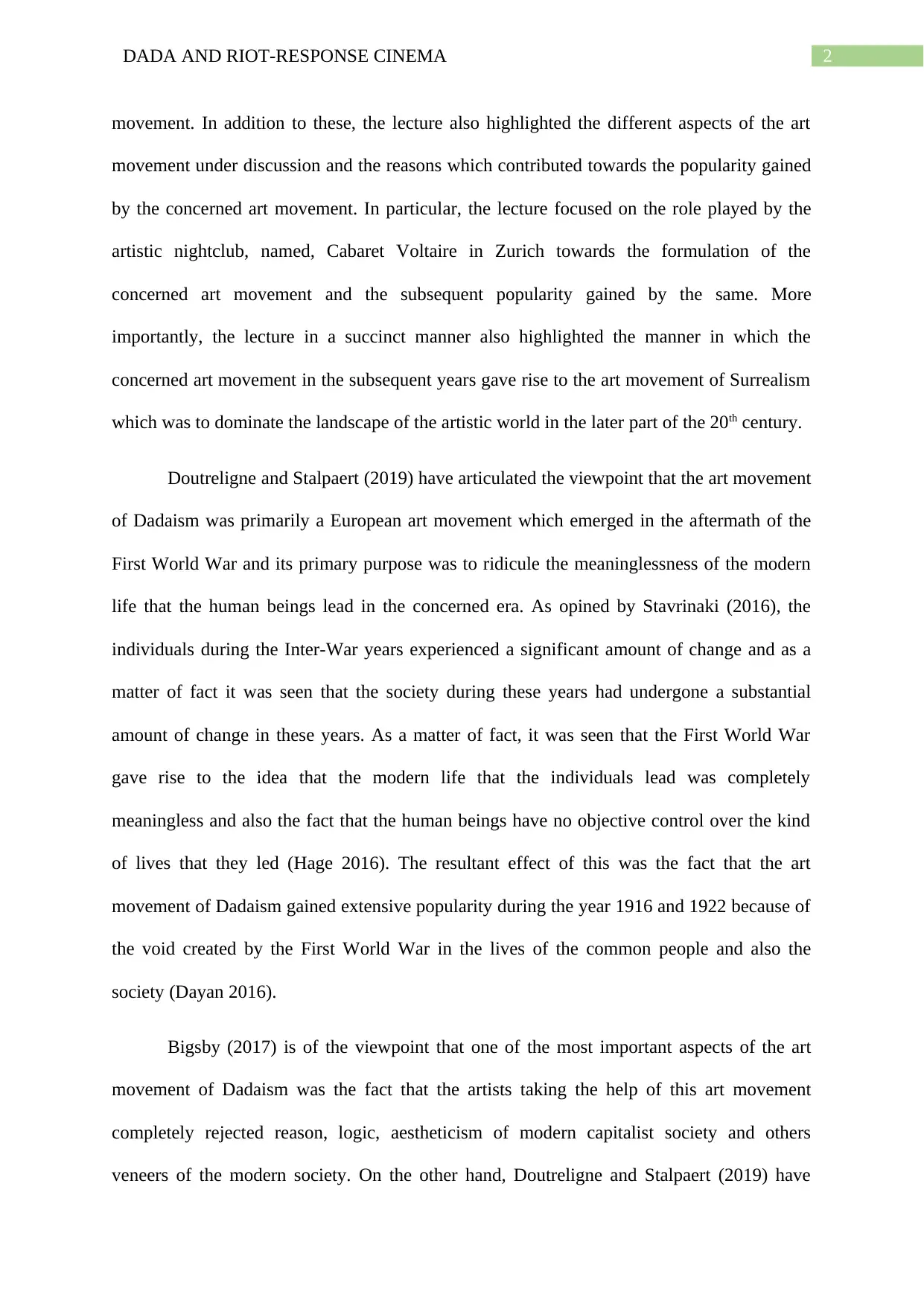
2DADA AND RIOT-RESPONSE CINEMA
movement. In addition to these, the lecture also highlighted the different aspects of the art
movement under discussion and the reasons which contributed towards the popularity gained
by the concerned art movement. In particular, the lecture focused on the role played by the
artistic nightclub, named, Cabaret Voltaire in Zurich towards the formulation of the
concerned art movement and the subsequent popularity gained by the same. More
importantly, the lecture in a succinct manner also highlighted the manner in which the
concerned art movement in the subsequent years gave rise to the art movement of Surrealism
which was to dominate the landscape of the artistic world in the later part of the 20th century.
Doutreligne and Stalpaert (2019) have articulated the viewpoint that the art movement
of Dadaism was primarily a European art movement which emerged in the aftermath of the
First World War and its primary purpose was to ridicule the meaninglessness of the modern
life that the human beings lead in the concerned era. As opined by Stavrinaki (2016), the
individuals during the Inter-War years experienced a significant amount of change and as a
matter of fact it was seen that the society during these years had undergone a substantial
amount of change in these years. As a matter of fact, it was seen that the First World War
gave rise to the idea that the modern life that the individuals lead was completely
meaningless and also the fact that the human beings have no objective control over the kind
of lives that they led (Hage 2016). The resultant effect of this was the fact that the art
movement of Dadaism gained extensive popularity during the year 1916 and 1922 because of
the void created by the First World War in the lives of the common people and also the
society (Dayan 2016).
Bigsby (2017) is of the viewpoint that one of the most important aspects of the art
movement of Dadaism was the fact that the artists taking the help of this art movement
completely rejected reason, logic, aestheticism of modern capitalist society and others
veneers of the modern society. On the other hand, Doutreligne and Stalpaert (2019) have
movement. In addition to these, the lecture also highlighted the different aspects of the art
movement under discussion and the reasons which contributed towards the popularity gained
by the concerned art movement. In particular, the lecture focused on the role played by the
artistic nightclub, named, Cabaret Voltaire in Zurich towards the formulation of the
concerned art movement and the subsequent popularity gained by the same. More
importantly, the lecture in a succinct manner also highlighted the manner in which the
concerned art movement in the subsequent years gave rise to the art movement of Surrealism
which was to dominate the landscape of the artistic world in the later part of the 20th century.
Doutreligne and Stalpaert (2019) have articulated the viewpoint that the art movement
of Dadaism was primarily a European art movement which emerged in the aftermath of the
First World War and its primary purpose was to ridicule the meaninglessness of the modern
life that the human beings lead in the concerned era. As opined by Stavrinaki (2016), the
individuals during the Inter-War years experienced a significant amount of change and as a
matter of fact it was seen that the society during these years had undergone a substantial
amount of change in these years. As a matter of fact, it was seen that the First World War
gave rise to the idea that the modern life that the individuals lead was completely
meaningless and also the fact that the human beings have no objective control over the kind
of lives that they led (Hage 2016). The resultant effect of this was the fact that the art
movement of Dadaism gained extensive popularity during the year 1916 and 1922 because of
the void created by the First World War in the lives of the common people and also the
society (Dayan 2016).
Bigsby (2017) is of the viewpoint that one of the most important aspects of the art
movement of Dadaism was the fact that the artists taking the help of this art movement
completely rejected reason, logic, aestheticism of modern capitalist society and others
veneers of the modern society. On the other hand, Doutreligne and Stalpaert (2019) have
⊘ This is a preview!⊘
Do you want full access?
Subscribe today to unlock all pages.

Trusted by 1+ million students worldwide

3DADA AND RIOT-RESPONSE CINEMA
noted that the artists taking the help of the art movement Dadaism tried to represent nonsense,
anti-bourgeois protest, irrationality and other aspects which were completely repudiated by
the societies of the earlier times. More importantly, it was noticed that rather than just being
contented with the cannon of art, the art movement under discussion here encompassed the
genres of music, poetry, motion pictures, scriptures and others as well (Forbes 2017). It is on
the score of the completely innovative nature of the ideas or the themes that the concerned art
movement tried to convey that the concerned art movement is often considered to be one of
the most important European avantgarde movements of the 20th century.
According to Fenton (2016), the roots of the art movement of Dadaism can be traced
back to the city of Zürich in the nation of Switzerland in the years immediately preceding the
First World War. As a matter of fact, the germs of the formulation of the concerned art
movements can be traced back to the artistic nightclub, named, Cabaret Voltaire in the city of
Zurich. In this regard, it needs to be said that the concerned nightclub was established by
Hugo Ball in collaboration with his partner Emmy Hennings, in the back room of
“Holländische Meierei, Spiegelgasse 1” in the year 1916 (Thelocal.ch 2019). The primary
idea behind the establishment of the artistic nightclub under discussion here was to offer a
social space to the different leading artists of the city of Zurich, which in the beginning of the
20th century was the home to some of the most important artists of the world, wherein they
can gather at night after the completion of their daily chores and discuss important matters
related to art, politics and other important matters of the time (Danesi 2018). Furthermore, it
was seen that the concerned artistic nightclub was frequented by some of the popular artists
of the era like Marcel Janco, Sophie Taeuber-Arp, Jean Arp, Tristan Tzara, Richard
Huelsenbeck and others who are often considered to be the founding fathers of the anarchic
art movement called Dadaism (Elsaesser 1996).
noted that the artists taking the help of the art movement Dadaism tried to represent nonsense,
anti-bourgeois protest, irrationality and other aspects which were completely repudiated by
the societies of the earlier times. More importantly, it was noticed that rather than just being
contented with the cannon of art, the art movement under discussion here encompassed the
genres of music, poetry, motion pictures, scriptures and others as well (Forbes 2017). It is on
the score of the completely innovative nature of the ideas or the themes that the concerned art
movement tried to convey that the concerned art movement is often considered to be one of
the most important European avantgarde movements of the 20th century.
According to Fenton (2016), the roots of the art movement of Dadaism can be traced
back to the city of Zürich in the nation of Switzerland in the years immediately preceding the
First World War. As a matter of fact, the germs of the formulation of the concerned art
movements can be traced back to the artistic nightclub, named, Cabaret Voltaire in the city of
Zurich. In this regard, it needs to be said that the concerned nightclub was established by
Hugo Ball in collaboration with his partner Emmy Hennings, in the back room of
“Holländische Meierei, Spiegelgasse 1” in the year 1916 (Thelocal.ch 2019). The primary
idea behind the establishment of the artistic nightclub under discussion here was to offer a
social space to the different leading artists of the city of Zurich, which in the beginning of the
20th century was the home to some of the most important artists of the world, wherein they
can gather at night after the completion of their daily chores and discuss important matters
related to art, politics and other important matters of the time (Danesi 2018). Furthermore, it
was seen that the concerned artistic nightclub was frequented by some of the popular artists
of the era like Marcel Janco, Sophie Taeuber-Arp, Jean Arp, Tristan Tzara, Richard
Huelsenbeck and others who are often considered to be the founding fathers of the anarchic
art movement called Dadaism (Elsaesser 1996).
Paraphrase This Document
Need a fresh take? Get an instant paraphrase of this document with our AI Paraphraser

4DADA AND RIOT-RESPONSE CINEMA
The official literary publication of the Cabaret Voltaire, named, “Pantagruel” in one
of its publications commenting on the concerned artistic nightclub stated that “The Cabaret
Voltaire. Under this name a group of young artists and writers has formed with the object of
becoming a center for artistic entertainment…. following their daily reunions, will give
musical or literary performances. Young Zürich artists, of all tendencies, are invited to join us
with suggestions and proposals” (Sooke 2019). As a matter of fact, it was seen that the
concerned artistic nightclub was the hub wherein different kinds of piano performances,
musical compositions and others were performed which in turn gave rise to the art movement
under discussion here (Thelocal.ch 2019). In this regard, it needs to be said that one thing was
common among all the artists from the different genres of art who visited the concerned
nightclub, the fact that they were all convinced regarding the meaninglessness of modern life
and thereby repudiated the constructs of logic, reason and others which the human society
had used over the years to render meaning to the lives that the individuals led. The resultant
effect of this was that the artists tried to convey the idea of the meaninglessness of the lives
that the individuals led through the usage of the art works and this in turn gave rise to the art
movement of Dadaism (Danesi 2018).
The week eight lecture “Riot and Response” focused on the riots in Handsworth,
Birmingham and London and the responses which were being given by the common people
of these areas in response to the riots. Grosvenor and Myers (2017) have articulated the
viewpoint that the human society over the years had faced different kinds of riots or struggles
and this in turn had formed the central lacuna of different kinds of art works, be it the literary
works, paintings or other forms of art. As a matter of fact, it had been seen that the
differences in the opinions held by the people, racial or ethnic differences and others have
contributed in a substantial manner towards the different riots or the struggles that the human
society had faced over the years (Connell 2019). However, the different kinds of riots despite
The official literary publication of the Cabaret Voltaire, named, “Pantagruel” in one
of its publications commenting on the concerned artistic nightclub stated that “The Cabaret
Voltaire. Under this name a group of young artists and writers has formed with the object of
becoming a center for artistic entertainment…. following their daily reunions, will give
musical or literary performances. Young Zürich artists, of all tendencies, are invited to join us
with suggestions and proposals” (Sooke 2019). As a matter of fact, it was seen that the
concerned artistic nightclub was the hub wherein different kinds of piano performances,
musical compositions and others were performed which in turn gave rise to the art movement
under discussion here (Thelocal.ch 2019). In this regard, it needs to be said that one thing was
common among all the artists from the different genres of art who visited the concerned
nightclub, the fact that they were all convinced regarding the meaninglessness of modern life
and thereby repudiated the constructs of logic, reason and others which the human society
had used over the years to render meaning to the lives that the individuals led. The resultant
effect of this was that the artists tried to convey the idea of the meaninglessness of the lives
that the individuals led through the usage of the art works and this in turn gave rise to the art
movement of Dadaism (Danesi 2018).
The week eight lecture “Riot and Response” focused on the riots in Handsworth,
Birmingham and London and the responses which were being given by the common people
of these areas in response to the riots. Grosvenor and Myers (2017) have articulated the
viewpoint that the human society over the years had faced different kinds of riots or struggles
and this in turn had formed the central lacuna of different kinds of art works, be it the literary
works, paintings or other forms of art. As a matter of fact, it had been seen that the
differences in the opinions held by the people, racial or ethnic differences and others have
contributed in a substantial manner towards the different riots or the struggles that the human
society had faced over the years (Connell 2019). However, the different kinds of riots despite
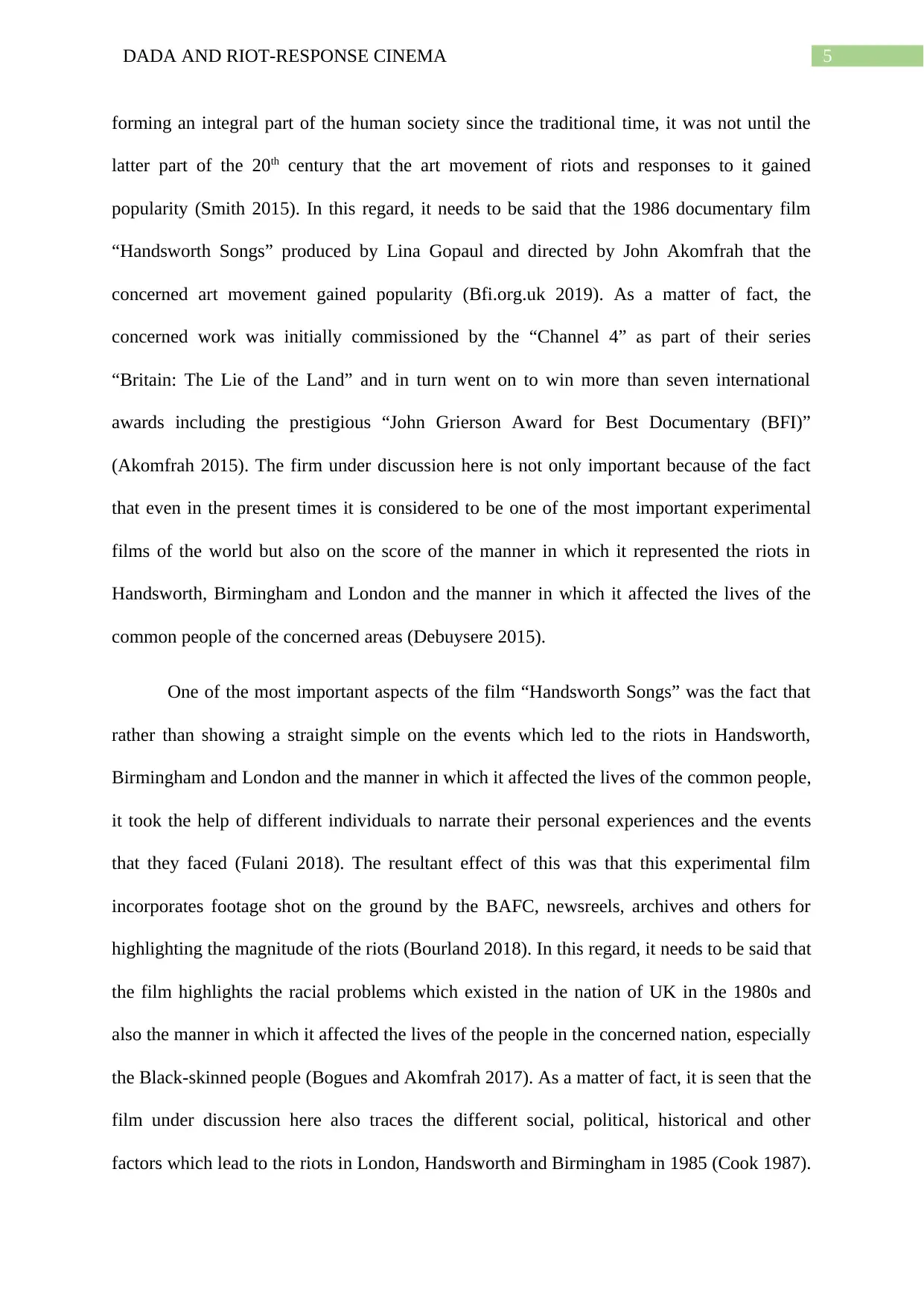
5DADA AND RIOT-RESPONSE CINEMA
forming an integral part of the human society since the traditional time, it was not until the
latter part of the 20th century that the art movement of riots and responses to it gained
popularity (Smith 2015). In this regard, it needs to be said that the 1986 documentary film
“Handsworth Songs” produced by Lina Gopaul and directed by John Akomfrah that the
concerned art movement gained popularity (Bfi.org.uk 2019). As a matter of fact, the
concerned work was initially commissioned by the “Channel 4” as part of their series
“Britain: The Lie of the Land” and in turn went on to win more than seven international
awards including the prestigious “John Grierson Award for Best Documentary (BFI)”
(Akomfrah 2015). The firm under discussion here is not only important because of the fact
that even in the present times it is considered to be one of the most important experimental
films of the world but also on the score of the manner in which it represented the riots in
Handsworth, Birmingham and London and the manner in which it affected the lives of the
common people of the concerned areas (Debuysere 2015).
One of the most important aspects of the film “Handsworth Songs” was the fact that
rather than showing a straight simple on the events which led to the riots in Handsworth,
Birmingham and London and the manner in which it affected the lives of the common people,
it took the help of different individuals to narrate their personal experiences and the events
that they faced (Fulani 2018). The resultant effect of this was that this experimental film
incorporates footage shot on the ground by the BAFC, newsreels, archives and others for
highlighting the magnitude of the riots (Bourland 2018). In this regard, it needs to be said that
the film highlights the racial problems which existed in the nation of UK in the 1980s and
also the manner in which it affected the lives of the people in the concerned nation, especially
the Black-skinned people (Bogues and Akomfrah 2017). As a matter of fact, it is seen that the
film under discussion here also traces the different social, political, historical and other
factors which lead to the riots in London, Handsworth and Birmingham in 1985 (Cook 1987).
forming an integral part of the human society since the traditional time, it was not until the
latter part of the 20th century that the art movement of riots and responses to it gained
popularity (Smith 2015). In this regard, it needs to be said that the 1986 documentary film
“Handsworth Songs” produced by Lina Gopaul and directed by John Akomfrah that the
concerned art movement gained popularity (Bfi.org.uk 2019). As a matter of fact, the
concerned work was initially commissioned by the “Channel 4” as part of their series
“Britain: The Lie of the Land” and in turn went on to win more than seven international
awards including the prestigious “John Grierson Award for Best Documentary (BFI)”
(Akomfrah 2015). The firm under discussion here is not only important because of the fact
that even in the present times it is considered to be one of the most important experimental
films of the world but also on the score of the manner in which it represented the riots in
Handsworth, Birmingham and London and the manner in which it affected the lives of the
common people of the concerned areas (Debuysere 2015).
One of the most important aspects of the film “Handsworth Songs” was the fact that
rather than showing a straight simple on the events which led to the riots in Handsworth,
Birmingham and London and the manner in which it affected the lives of the common people,
it took the help of different individuals to narrate their personal experiences and the events
that they faced (Fulani 2018). The resultant effect of this was that this experimental film
incorporates footage shot on the ground by the BAFC, newsreels, archives and others for
highlighting the magnitude of the riots (Bourland 2018). In this regard, it needs to be said that
the film highlights the racial problems which existed in the nation of UK in the 1980s and
also the manner in which it affected the lives of the people in the concerned nation, especially
the Black-skinned people (Bogues and Akomfrah 2017). As a matter of fact, it is seen that the
film under discussion here also traces the different social, political, historical and other
factors which lead to the riots in London, Handsworth and Birmingham in 1985 (Cook 1987).
⊘ This is a preview!⊘
Do you want full access?
Subscribe today to unlock all pages.

Trusted by 1+ million students worldwide
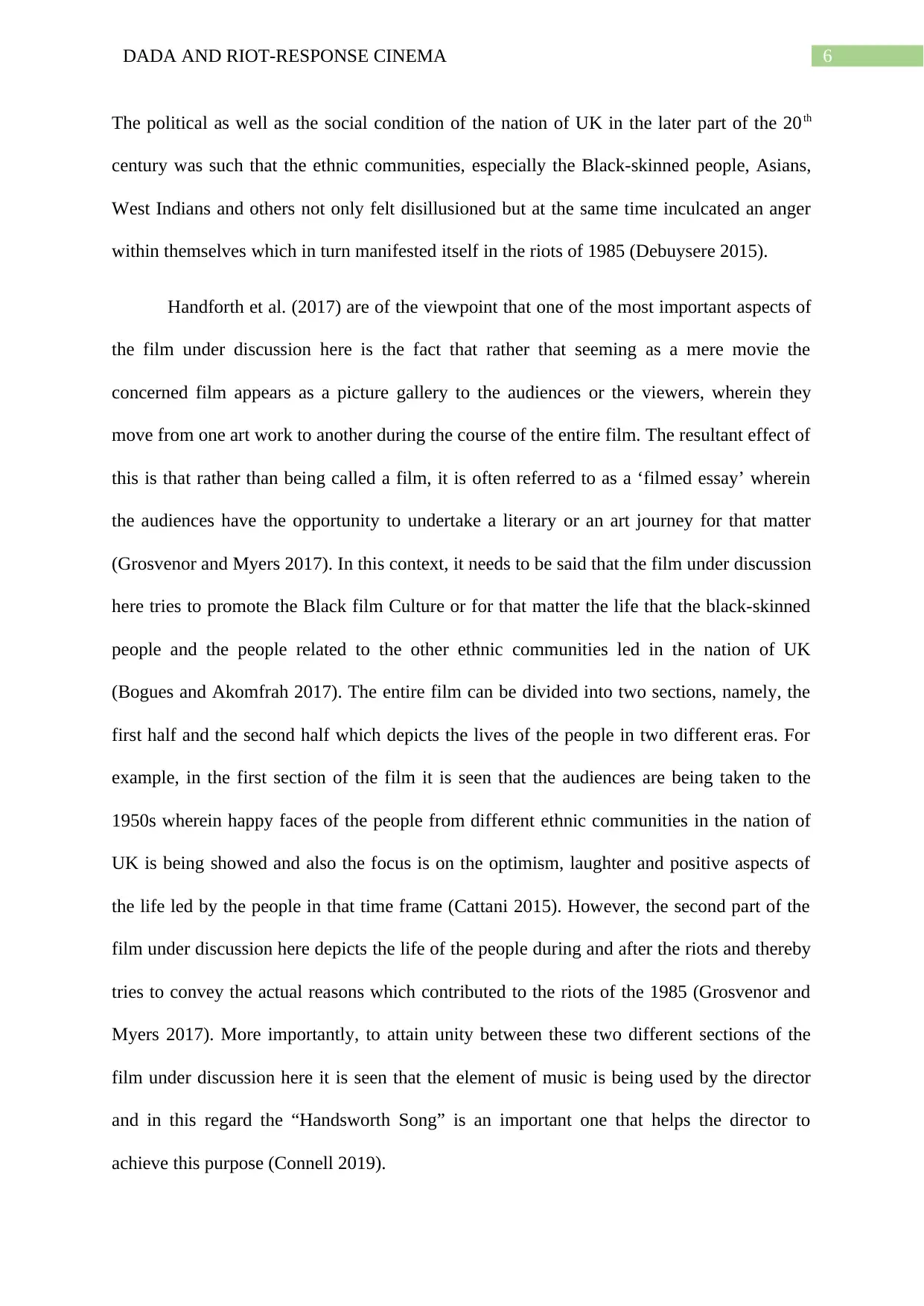
6DADA AND RIOT-RESPONSE CINEMA
The political as well as the social condition of the nation of UK in the later part of the 20th
century was such that the ethnic communities, especially the Black-skinned people, Asians,
West Indians and others not only felt disillusioned but at the same time inculcated an anger
within themselves which in turn manifested itself in the riots of 1985 (Debuysere 2015).
Handforth et al. (2017) are of the viewpoint that one of the most important aspects of
the film under discussion here is the fact that rather that seeming as a mere movie the
concerned film appears as a picture gallery to the audiences or the viewers, wherein they
move from one art work to another during the course of the entire film. The resultant effect of
this is that rather than being called a film, it is often referred to as a ‘filmed essay’ wherein
the audiences have the opportunity to undertake a literary or an art journey for that matter
(Grosvenor and Myers 2017). In this context, it needs to be said that the film under discussion
here tries to promote the Black film Culture or for that matter the life that the black-skinned
people and the people related to the other ethnic communities led in the nation of UK
(Bogues and Akomfrah 2017). The entire film can be divided into two sections, namely, the
first half and the second half which depicts the lives of the people in two different eras. For
example, in the first section of the film it is seen that the audiences are being taken to the
1950s wherein happy faces of the people from different ethnic communities in the nation of
UK is being showed and also the focus is on the optimism, laughter and positive aspects of
the life led by the people in that time frame (Cattani 2015). However, the second part of the
film under discussion here depicts the life of the people during and after the riots and thereby
tries to convey the actual reasons which contributed to the riots of the 1985 (Grosvenor and
Myers 2017). More importantly, to attain unity between these two different sections of the
film under discussion here it is seen that the element of music is being used by the director
and in this regard the “Handsworth Song” is an important one that helps the director to
achieve this purpose (Connell 2019).
The political as well as the social condition of the nation of UK in the later part of the 20th
century was such that the ethnic communities, especially the Black-skinned people, Asians,
West Indians and others not only felt disillusioned but at the same time inculcated an anger
within themselves which in turn manifested itself in the riots of 1985 (Debuysere 2015).
Handforth et al. (2017) are of the viewpoint that one of the most important aspects of
the film under discussion here is the fact that rather that seeming as a mere movie the
concerned film appears as a picture gallery to the audiences or the viewers, wherein they
move from one art work to another during the course of the entire film. The resultant effect of
this is that rather than being called a film, it is often referred to as a ‘filmed essay’ wherein
the audiences have the opportunity to undertake a literary or an art journey for that matter
(Grosvenor and Myers 2017). In this context, it needs to be said that the film under discussion
here tries to promote the Black film Culture or for that matter the life that the black-skinned
people and the people related to the other ethnic communities led in the nation of UK
(Bogues and Akomfrah 2017). The entire film can be divided into two sections, namely, the
first half and the second half which depicts the lives of the people in two different eras. For
example, in the first section of the film it is seen that the audiences are being taken to the
1950s wherein happy faces of the people from different ethnic communities in the nation of
UK is being showed and also the focus is on the optimism, laughter and positive aspects of
the life led by the people in that time frame (Cattani 2015). However, the second part of the
film under discussion here depicts the life of the people during and after the riots and thereby
tries to convey the actual reasons which contributed to the riots of the 1985 (Grosvenor and
Myers 2017). More importantly, to attain unity between these two different sections of the
film under discussion here it is seen that the element of music is being used by the director
and in this regard the “Handsworth Song” is an important one that helps the director to
achieve this purpose (Connell 2019).
Paraphrase This Document
Need a fresh take? Get an instant paraphrase of this document with our AI Paraphraser

7DADA AND RIOT-RESPONSE CINEMA
A close analysis of the role played by the Cabaret Voltaire in Zurich towards the
emergence of the art movement of Dadaism and the role of the riots in 1985 in London,
Birmingham and Handsworth towards the creation of the film essay “Handsworth Songs” in a
succinct manner highlights the role played by society or societal events towards the creation
or art. As a matter of fact, it was seen that the artistic discussions within the artistic nightclub,
Cabaret Voltaire in Zurich, carried the germs which in turn gave birth to the art movement of
Dadaism (Doutreligne and Stalpaert 2019). Furthermore, without the nightclub under
discussion here the different artists who contributed in an effective manner towards the
development of the art movement Dadaism would not have been able to come together and
thereby share their artistic vision or ideas (Dayan 2016). In addition to this, the liberal
environment which existed within the framework of the concerned artistic nightclub afforded
the opportunity to try out new art forms for the representation of the idea of the
meaninglessness of the modern lives that the human beings (Sooke 2019). On the score of
these aspects, it can be said that the artistic nightclub under discussion here played a pivotal
role towards the formulation as well as the widespread popularity that the art movement of
Dadaism gained between the years 1916 and 1922. On the other hand, the riots of 1985 which
adversely affected the lives of the black-skinned people and the people related to the other
ethnic communities led to the creation of the film “Handsworth Songs” (Bogues and
Akomfrah 2017). In this regard, it needs to be said that the riots of 1985 gave the idea to John
Akomfrah and Lina Gopaul for the creation of the concerned film. However, at the same time
it needs to be said that the director of the film under discussion realised the pitfalls of the
contemporary motion pictures of that time and thereby did not want his film to have the same
defects or for that follow the same line of production (Grosvenor and Myers 2017). The
resultant effect of this was that the director of the film took the help of the concept of film
essay and thereby created the kind of film which rather than narrating the events or the
A close analysis of the role played by the Cabaret Voltaire in Zurich towards the
emergence of the art movement of Dadaism and the role of the riots in 1985 in London,
Birmingham and Handsworth towards the creation of the film essay “Handsworth Songs” in a
succinct manner highlights the role played by society or societal events towards the creation
or art. As a matter of fact, it was seen that the artistic discussions within the artistic nightclub,
Cabaret Voltaire in Zurich, carried the germs which in turn gave birth to the art movement of
Dadaism (Doutreligne and Stalpaert 2019). Furthermore, without the nightclub under
discussion here the different artists who contributed in an effective manner towards the
development of the art movement Dadaism would not have been able to come together and
thereby share their artistic vision or ideas (Dayan 2016). In addition to this, the liberal
environment which existed within the framework of the concerned artistic nightclub afforded
the opportunity to try out new art forms for the representation of the idea of the
meaninglessness of the modern lives that the human beings (Sooke 2019). On the score of
these aspects, it can be said that the artistic nightclub under discussion here played a pivotal
role towards the formulation as well as the widespread popularity that the art movement of
Dadaism gained between the years 1916 and 1922. On the other hand, the riots of 1985 which
adversely affected the lives of the black-skinned people and the people related to the other
ethnic communities led to the creation of the film “Handsworth Songs” (Bogues and
Akomfrah 2017). In this regard, it needs to be said that the riots of 1985 gave the idea to John
Akomfrah and Lina Gopaul for the creation of the concerned film. However, at the same time
it needs to be said that the director of the film under discussion realised the pitfalls of the
contemporary motion pictures of that time and thereby did not want his film to have the same
defects or for that follow the same line of production (Grosvenor and Myers 2017). The
resultant effect of this was that the director of the film took the help of the concept of film
essay and thereby created the kind of film which rather than narrating the events or the
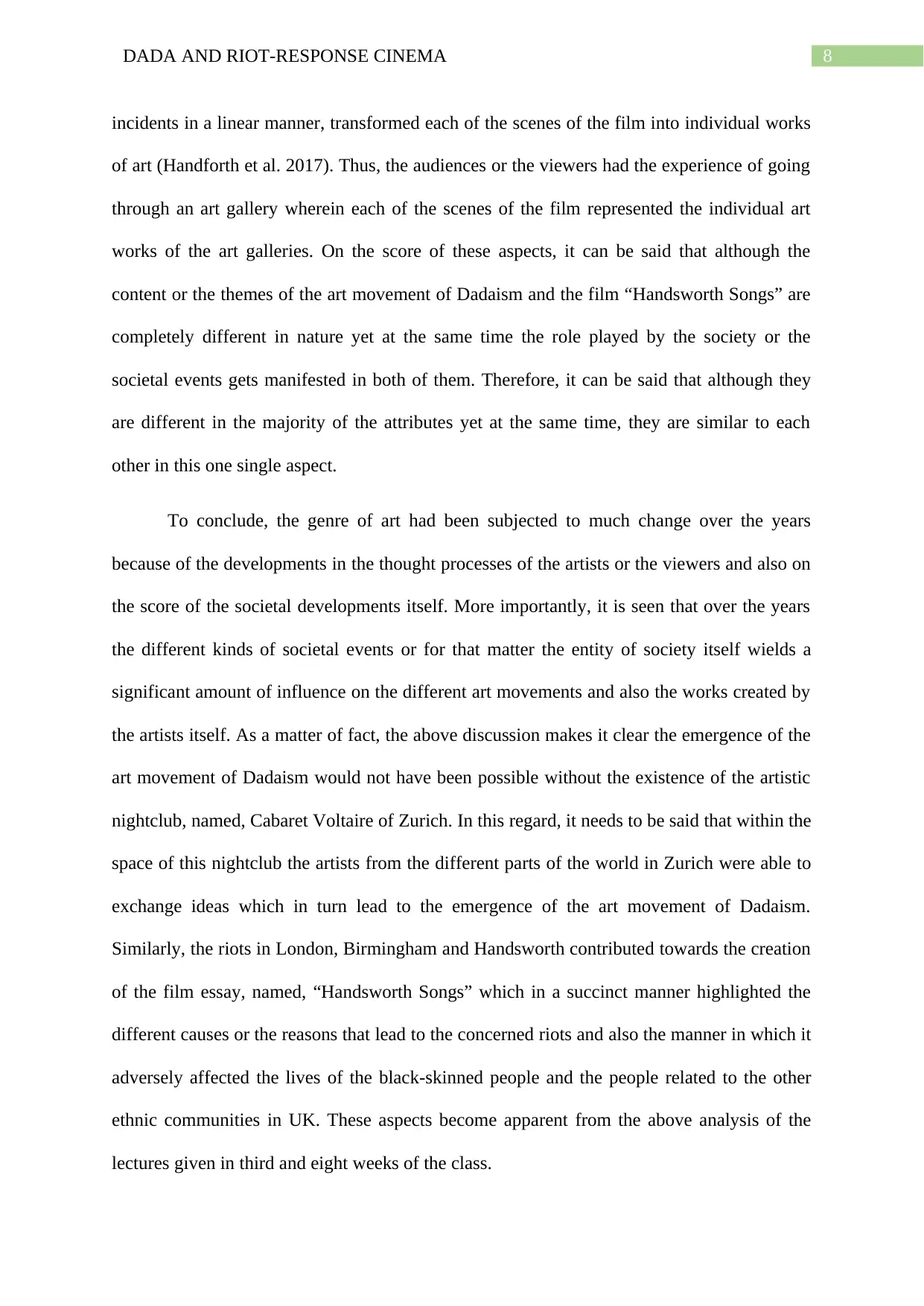
8DADA AND RIOT-RESPONSE CINEMA
incidents in a linear manner, transformed each of the scenes of the film into individual works
of art (Handforth et al. 2017). Thus, the audiences or the viewers had the experience of going
through an art gallery wherein each of the scenes of the film represented the individual art
works of the art galleries. On the score of these aspects, it can be said that although the
content or the themes of the art movement of Dadaism and the film “Handsworth Songs” are
completely different in nature yet at the same time the role played by the society or the
societal events gets manifested in both of them. Therefore, it can be said that although they
are different in the majority of the attributes yet at the same time, they are similar to each
other in this one single aspect.
To conclude, the genre of art had been subjected to much change over the years
because of the developments in the thought processes of the artists or the viewers and also on
the score of the societal developments itself. More importantly, it is seen that over the years
the different kinds of societal events or for that matter the entity of society itself wields a
significant amount of influence on the different art movements and also the works created by
the artists itself. As a matter of fact, the above discussion makes it clear the emergence of the
art movement of Dadaism would not have been possible without the existence of the artistic
nightclub, named, Cabaret Voltaire of Zurich. In this regard, it needs to be said that within the
space of this nightclub the artists from the different parts of the world in Zurich were able to
exchange ideas which in turn lead to the emergence of the art movement of Dadaism.
Similarly, the riots in London, Birmingham and Handsworth contributed towards the creation
of the film essay, named, “Handsworth Songs” which in a succinct manner highlighted the
different causes or the reasons that lead to the concerned riots and also the manner in which it
adversely affected the lives of the black-skinned people and the people related to the other
ethnic communities in UK. These aspects become apparent from the above analysis of the
lectures given in third and eight weeks of the class.
incidents in a linear manner, transformed each of the scenes of the film into individual works
of art (Handforth et al. 2017). Thus, the audiences or the viewers had the experience of going
through an art gallery wherein each of the scenes of the film represented the individual art
works of the art galleries. On the score of these aspects, it can be said that although the
content or the themes of the art movement of Dadaism and the film “Handsworth Songs” are
completely different in nature yet at the same time the role played by the society or the
societal events gets manifested in both of them. Therefore, it can be said that although they
are different in the majority of the attributes yet at the same time, they are similar to each
other in this one single aspect.
To conclude, the genre of art had been subjected to much change over the years
because of the developments in the thought processes of the artists or the viewers and also on
the score of the societal developments itself. More importantly, it is seen that over the years
the different kinds of societal events or for that matter the entity of society itself wields a
significant amount of influence on the different art movements and also the works created by
the artists itself. As a matter of fact, the above discussion makes it clear the emergence of the
art movement of Dadaism would not have been possible without the existence of the artistic
nightclub, named, Cabaret Voltaire of Zurich. In this regard, it needs to be said that within the
space of this nightclub the artists from the different parts of the world in Zurich were able to
exchange ideas which in turn lead to the emergence of the art movement of Dadaism.
Similarly, the riots in London, Birmingham and Handsworth contributed towards the creation
of the film essay, named, “Handsworth Songs” which in a succinct manner highlighted the
different causes or the reasons that lead to the concerned riots and also the manner in which it
adversely affected the lives of the black-skinned people and the people related to the other
ethnic communities in UK. These aspects become apparent from the above analysis of the
lectures given in third and eight weeks of the class.
⊘ This is a preview!⊘
Do you want full access?
Subscribe today to unlock all pages.

Trusted by 1+ million students worldwide

9DADA AND RIOT-RESPONSE CINEMA
Paraphrase This Document
Need a fresh take? Get an instant paraphrase of this document with our AI Paraphraser
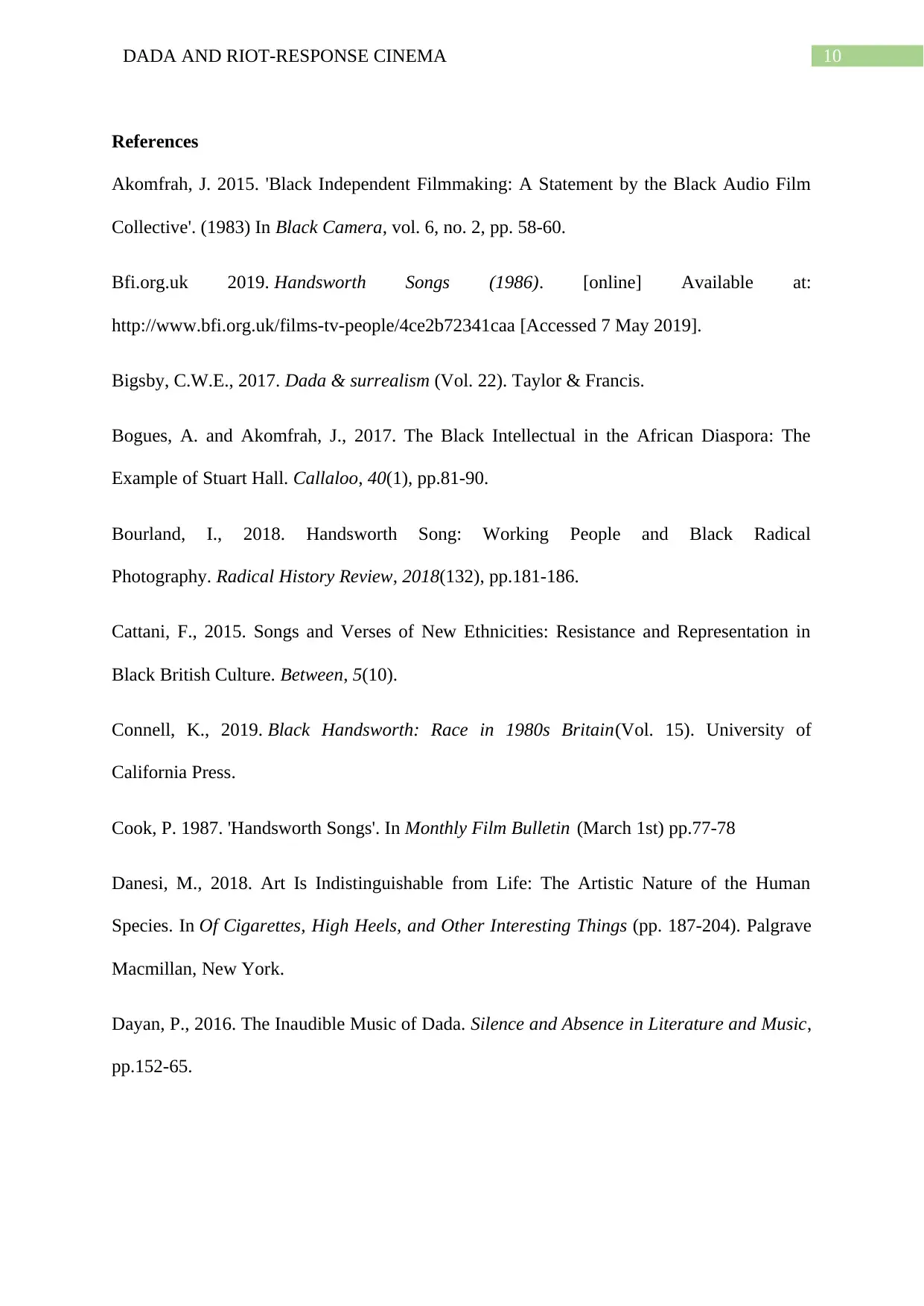
10DADA AND RIOT-RESPONSE CINEMA
References
Akomfrah, J. 2015. 'Black Independent Filmmaking: A Statement by the Black Audio Film
Collective'. (1983) In Black Camera, vol. 6, no. 2, pp. 58-60.
Bfi.org.uk 2019. Handsworth Songs (1986). [online] Available at:
http://www.bfi.org.uk/films-tv-people/4ce2b72341caa [Accessed 7 May 2019].
Bigsby, C.W.E., 2017. Dada & surrealism (Vol. 22). Taylor & Francis.
Bogues, A. and Akomfrah, J., 2017. The Black Intellectual in the African Diaspora: The
Example of Stuart Hall. Callaloo, 40(1), pp.81-90.
Bourland, I., 2018. Handsworth Song: Working People and Black Radical
Photography. Radical History Review, 2018(132), pp.181-186.
Cattani, F., 2015. Songs and Verses of New Ethnicities: Resistance and Representation in
Black British Culture. Between, 5(10).
Connell, K., 2019. Black Handsworth: Race in 1980s Britain(Vol. 15). University of
California Press.
Cook, P. 1987. 'Handsworth Songs'. In Monthly Film Bulletin (March 1st) pp.77-78
Danesi, M., 2018. Art Is Indistinguishable from Life: The Artistic Nature of the Human
Species. In Of Cigarettes, High Heels, and Other Interesting Things (pp. 187-204). Palgrave
Macmillan, New York.
Dayan, P., 2016. The Inaudible Music of Dada. Silence and Absence in Literature and Music,
pp.152-65.
References
Akomfrah, J. 2015. 'Black Independent Filmmaking: A Statement by the Black Audio Film
Collective'. (1983) In Black Camera, vol. 6, no. 2, pp. 58-60.
Bfi.org.uk 2019. Handsworth Songs (1986). [online] Available at:
http://www.bfi.org.uk/films-tv-people/4ce2b72341caa [Accessed 7 May 2019].
Bigsby, C.W.E., 2017. Dada & surrealism (Vol. 22). Taylor & Francis.
Bogues, A. and Akomfrah, J., 2017. The Black Intellectual in the African Diaspora: The
Example of Stuart Hall. Callaloo, 40(1), pp.81-90.
Bourland, I., 2018. Handsworth Song: Working People and Black Radical
Photography. Radical History Review, 2018(132), pp.181-186.
Cattani, F., 2015. Songs and Verses of New Ethnicities: Resistance and Representation in
Black British Culture. Between, 5(10).
Connell, K., 2019. Black Handsworth: Race in 1980s Britain(Vol. 15). University of
California Press.
Cook, P. 1987. 'Handsworth Songs'. In Monthly Film Bulletin (March 1st) pp.77-78
Danesi, M., 2018. Art Is Indistinguishable from Life: The Artistic Nature of the Human
Species. In Of Cigarettes, High Heels, and Other Interesting Things (pp. 187-204). Palgrave
Macmillan, New York.
Dayan, P., 2016. The Inaudible Music of Dada. Silence and Absence in Literature and Music,
pp.152-65.
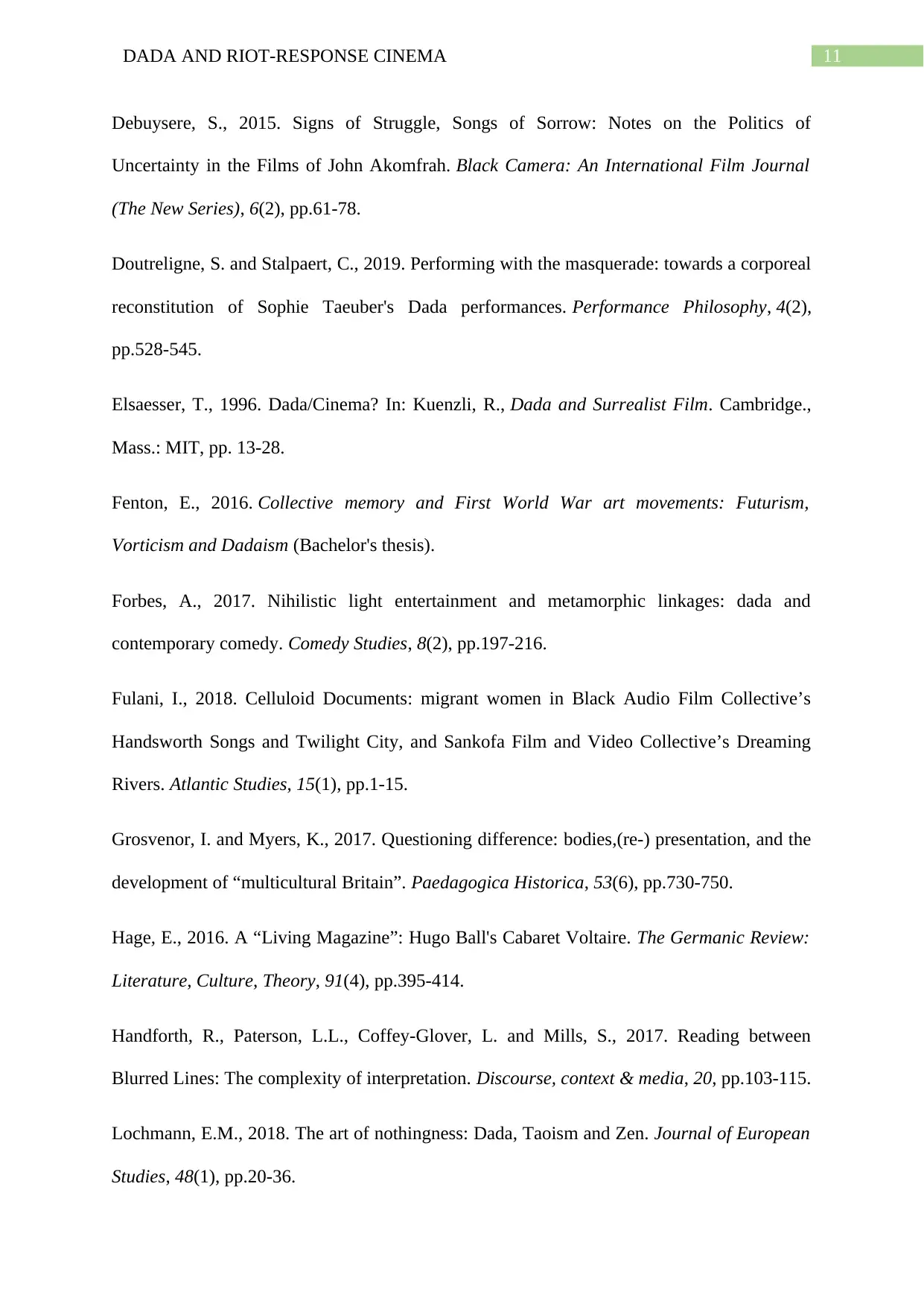
11DADA AND RIOT-RESPONSE CINEMA
Debuysere, S., 2015. Signs of Struggle, Songs of Sorrow: Notes on the Politics of
Uncertainty in the Films of John Akomfrah. Black Camera: An International Film Journal
(The New Series), 6(2), pp.61-78.
Doutreligne, S. and Stalpaert, C., 2019. Performing with the masquerade: towards a corporeal
reconstitution of Sophie Taeuber's Dada performances. Performance Philosophy, 4(2),
pp.528-545.
Elsaesser, T., 1996. Dada/Cinema? In: Kuenzli, R., Dada and Surrealist Film. Cambridge.,
Mass.: MIT, pp. 13-28.
Fenton, E., 2016. Collective memory and First World War art movements: Futurism,
Vorticism and Dadaism (Bachelor's thesis).
Forbes, A., 2017. Nihilistic light entertainment and metamorphic linkages: dada and
contemporary comedy. Comedy Studies, 8(2), pp.197-216.
Fulani, I., 2018. Celluloid Documents: migrant women in Black Audio Film Collective’s
Handsworth Songs and Twilight City, and Sankofa Film and Video Collective’s Dreaming
Rivers. Atlantic Studies, 15(1), pp.1-15.
Grosvenor, I. and Myers, K., 2017. Questioning difference: bodies,(re-) presentation, and the
development of “multicultural Britain”. Paedagogica Historica, 53(6), pp.730-750.
Hage, E., 2016. A “Living Magazine”: Hugo Ball's Cabaret Voltaire. The Germanic Review:
Literature, Culture, Theory, 91(4), pp.395-414.
Handforth, R., Paterson, L.L., Coffey-Glover, L. and Mills, S., 2017. Reading between
Blurred Lines: The complexity of interpretation. Discourse, context & media, 20, pp.103-115.
Lochmann, E.M., 2018. The art of nothingness: Dada, Taoism and Zen. Journal of European
Studies, 48(1), pp.20-36.
Debuysere, S., 2015. Signs of Struggle, Songs of Sorrow: Notes on the Politics of
Uncertainty in the Films of John Akomfrah. Black Camera: An International Film Journal
(The New Series), 6(2), pp.61-78.
Doutreligne, S. and Stalpaert, C., 2019. Performing with the masquerade: towards a corporeal
reconstitution of Sophie Taeuber's Dada performances. Performance Philosophy, 4(2),
pp.528-545.
Elsaesser, T., 1996. Dada/Cinema? In: Kuenzli, R., Dada and Surrealist Film. Cambridge.,
Mass.: MIT, pp. 13-28.
Fenton, E., 2016. Collective memory and First World War art movements: Futurism,
Vorticism and Dadaism (Bachelor's thesis).
Forbes, A., 2017. Nihilistic light entertainment and metamorphic linkages: dada and
contemporary comedy. Comedy Studies, 8(2), pp.197-216.
Fulani, I., 2018. Celluloid Documents: migrant women in Black Audio Film Collective’s
Handsworth Songs and Twilight City, and Sankofa Film and Video Collective’s Dreaming
Rivers. Atlantic Studies, 15(1), pp.1-15.
Grosvenor, I. and Myers, K., 2017. Questioning difference: bodies,(re-) presentation, and the
development of “multicultural Britain”. Paedagogica Historica, 53(6), pp.730-750.
Hage, E., 2016. A “Living Magazine”: Hugo Ball's Cabaret Voltaire. The Germanic Review:
Literature, Culture, Theory, 91(4), pp.395-414.
Handforth, R., Paterson, L.L., Coffey-Glover, L. and Mills, S., 2017. Reading between
Blurred Lines: The complexity of interpretation. Discourse, context & media, 20, pp.103-115.
Lochmann, E.M., 2018. The art of nothingness: Dada, Taoism and Zen. Journal of European
Studies, 48(1), pp.20-36.
⊘ This is a preview!⊘
Do you want full access?
Subscribe today to unlock all pages.

Trusted by 1+ million students worldwide
1 out of 13
Your All-in-One AI-Powered Toolkit for Academic Success.
+13062052269
info@desklib.com
Available 24*7 on WhatsApp / Email
![[object Object]](/_next/static/media/star-bottom.7253800d.svg)
Unlock your academic potential
Copyright © 2020–2026 A2Z Services. All Rights Reserved. Developed and managed by ZUCOL.